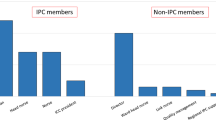Abstract
BACKGROUND: The Centers for Disease Control and Prevention (CDC) Guideline for Hand Hygiene in Health Care Settings was issued in 2002. In 2003, the Joint Commission on Accreditation of Healthcare Organizations (JCAHO) established complying with the CDC Guideline as a National Patient Safety Goal for 2004. This goal has been maintained through 2006. The CDC’s emphasis on the use of alcohol-based hand rubs (ABHRs) rather than soap and water was an opportunity to improve compliance, but the Guideline contained over 40 specific recommendations to implement.
OBJECTIVE: To use the Six Sigma process to examine hand hygiene practices and increase compliance with the CDC hand hygiene recommendations required by JCAHO.
DESIGN: Six Sigma Project with pre-post design.
PARTICIPANTS: Physicians, nurses, and other staff working in 4 intensive care units at 3 hospitals.
MEASUREMENTS: Observed compliance with 10 required hand hygiene practices, mass of ABHR used per month per 100 patient-days, and staff attitudes and perceptions regarding hand hygiene reported by questionnaire.
RESULTS: Observed compliance increased from 47% to 80%, based on over 4,000 total observations. The mass of ABHR used per 100 patient-days in 3 intensive care units (ICUs) increased by 97%, 94%, and 70%; increases were sustained for 9 months. Self-reported compliance using the questionnaire did not change. Staff reported increased use of ABHR and increased satisfaction with hand hygiene practices and products.
CONCLUSIONS: The Six Sigma process was effective for organizing the knowledge, opinions, and actions of a group of professionals to implement the CDC’s evidence-based hand hygiene practices in 4 ICUs. Several tools were developed for widespread use.
Similar content being viewed by others
References
Semmelweis I. In: Etiology, Concept, and Prophylaxis of Childbed Fever Carter KC, ed. 1st edn. Madison, WI: The University of Wisconsin Press; 1983.
Institute of Medicine. Priority Areas for National Action. Washington, DC: National Academies Press; 2003.
Boyce JM. MRSA patients: proven methods to treat colonization. J Hosp Infect. 2001;48(suppl A):S9–14.
Larson E. Skin hygiene and infection prevention: more of the same or different approaches? Clin Infec Dis. 1999;29:1287–94.
Leape LL, Brennan TA, Laird N, et al. The nature of adverse events in hospitalized patients. N Engl J Med. 1991;324:377–84.
CDC NNIS System. National Noscomial Infections Surveillance (NNIS) system report, data summary from January 1992 to June 2002, issued August 2002. Am J Infect Control. 2002;30:458–75.
CDC. Guideline for hand hygiene in health-care settings. Recommendations of the Healthcare Infection Control Practices Advisory Committee and the HICPAC/SHEA/APIC/IDSA Hand Hygiene Task Force. Morb Mortal Wkly Rep. 2002;51:(No. RR-16).
MacDonald A, Dinah F, MacKenzie D, Wilson A. Performance feedback of hand hygiene, using alcohol gel as the skin decontaminant, reduces the number of inpatients newly affected by MRSA and antibiotic costs. J Hospital Infec. 2004;56:56–63.
Hilburn J, Hammond B, Fendler EJ, Groziak PA. Use of alcohol hand sanitizer as an infection control strategy in an acute care facility. Am J Infect Control. 2003;31:109–16.
Fendler EJ, Ali Y, Hammond BS, Lyons MK, Kelley MB, Vowell NA. The impact of alcohol hand sanitizer use on infection rates in an extended care facility. Am J Infect Control. 2002;30:226–33.
Harbath S. Handwashing—The Semmelweis lesson misunderstood? Clin Infec Dis. 2000;30:990–1.
Pande PS, Neuman RP, Cavanagh RR. The Six Sigma Way: How GE, Motorola, and Other Top Companies are Honing their Performance. New York, NY: McGraw Hill; 2000.
Rath T, Strong DO. Rath & Strong’s Six Sigma Pocket Guide. Lexington, MA: AON Consulting Worldwide; 2002.
Department of Veterans Affairs, National Center for Patient Safety, Hand Hygiene Information and Tools. Available at: http://vaww.ncps.med.va.gov/Hand_Hygiene/InfoTools/index.html. Accessed August 10, 2005.
Larson E. Prevalence and correlates of skin damage on the hands of nurses. Heart Lung. 1997;26:404–12.
Weinstein RA. Controlling antimicrobial resistance in hospitals: infection control and use of antibiotics. Emerging Infec Dis. 2001;7:188–92.
Department of Veterans Affairs. Office of Public Health and Environmental Hazards. Infection: Don’t Pass it on. Available at: http://www.publichealth.va.gov/infectiondontpassiton/. Accessed August 10, 2005.
Burke JP. Infection control—a problem for patient safety. N Engl J Med. 2003;348:651–6.
Wenzel RP, Edmond MB. The impact of hospital-acquired bloodstream infections. Emerging Infec Dis. 2001;7:174–7.
Weinstein RA. Nosocomial infection update. Emerging Infec Dis. 1998;4:416–20.
Eggimann P, Pittet D. Infection control in the ICU. Chest. 2001;120:2059–93.
Hospital Infections Program, National Center for Infectious Diseases, CDC. Public health focus: surveillance, prevention, and control of nosocomial infections. Morb Mortal Wkly Rep. 1992;41:783–7.
Girou E, Stephan F, Novara A, Safar M, Fagon J-Y. Risk factors and outcome of nosocomial infections: results of a matched casecontrol study of ICU patients. Am J Respir Crit Care Med. 1998;157:1151–8.
Bischoff WE, Reynolds TM, Sessler CN, Edmond MB, Wenzel RP. Handwashing compliance by health care workers: the impact of introducing an accessible alcohol-based hand antiseptic. Arch Intern Med. 2000;160:1017–21.
Author information
Authors and Affiliations
Corresponding author
Additional information
The authors have no conflict of interest to declare for this article.
Rights and permissions
About this article
Cite this article
Eldridge, N.E., Woods, S.S., Bonello, R.S. et al. Using the six sigma process to implement the centers for disease control and prevention guideline for hand hygiene in 4 intensive care units. J Gen Intern Med 21 (Suppl 2), S35–S42 (2006). https://doi.org/10.1007/s11606-006-0273-y
Issue Date:
DOI: https://doi.org/10.1007/s11606-006-0273-y




